To capture razor-sharp images, you’ll need precision focusing rails for micro-adjustments, back button focus to separate focusing from shutter release, and focus peaking to highlight in-focus areas. Try Z-stack software for extended depth of field, high-resolution monitors for detail verification, and piezoelectric controllers for nanometer-level precision. Don’t forget calibrated stage micrometers, phase contrast objectives, differential interference contrast systems, and motorized XYZ positioning. These tools will transform your photography from merely focused to stunningly crisp.
10 Essential Focal Plane Tools for Sharp Photography
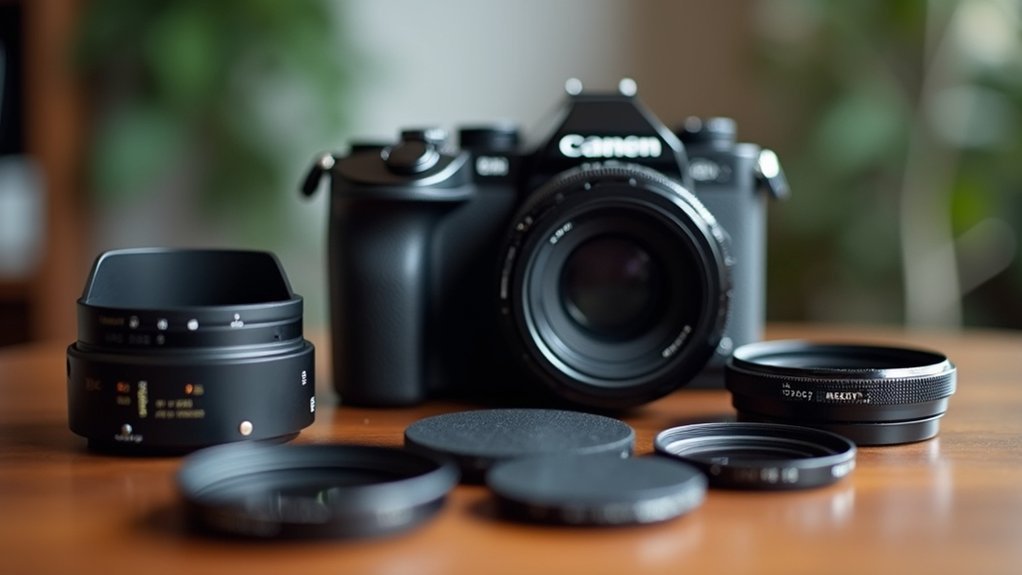
Precision in photography begins at the focal plane—that specific distance where your lens focuses with ideal sharpness.
To consistently capture sharp images, you’ll need to master several essential tools.
Focus peaking provides real-time visual feedback by highlighting in-focus areas, dramatically improving your manual focus accuracy. Pair this with back button focus to maintain precise control while shooting, separating focus acquisition from shutter release for more consistent results.
Don’t overlook aperture adjustments, which directly affect depth of field. Smaller apertures extend the zone of acceptable sharpness—perfect for landscapes and group shots where multiple subjects need clarity.
Always verify focus on your camera’s display, especially with telephoto lenses. This quick check prevents disappointing results and guarantees your intended subjects remain within the critical focal plane.
Precision Focusing Rails for Micro-Adjustments
When capturing subjects at extremely close range, even the slightest movement can shift your focal plane dramatically. Precision focusing rails offer you the control needed for achieving tack-sharp photos in challenging situations.
These specialized tools feature graduated markings that enable micro-adjustments in multiple directions, particularly valuable when working with limited depth of field.
For maximum image sharpness, consider these key benefits:
- Fine-tuning knobs allow for delicate positioning adjustments even in difficult lighting conditions
- Lightweight yet sturdy construction won’t compromise your mobility in the field
- Versatility extends beyond macro work to landscape photography where precise focus stacking demands exact positioning
You’ll find these rails particularly indispensable when traditional focusing methods fall short, especially during extreme close-ups where even breathing can affect your perfect shot.
Z-Stack Software for Extended Depth of Field
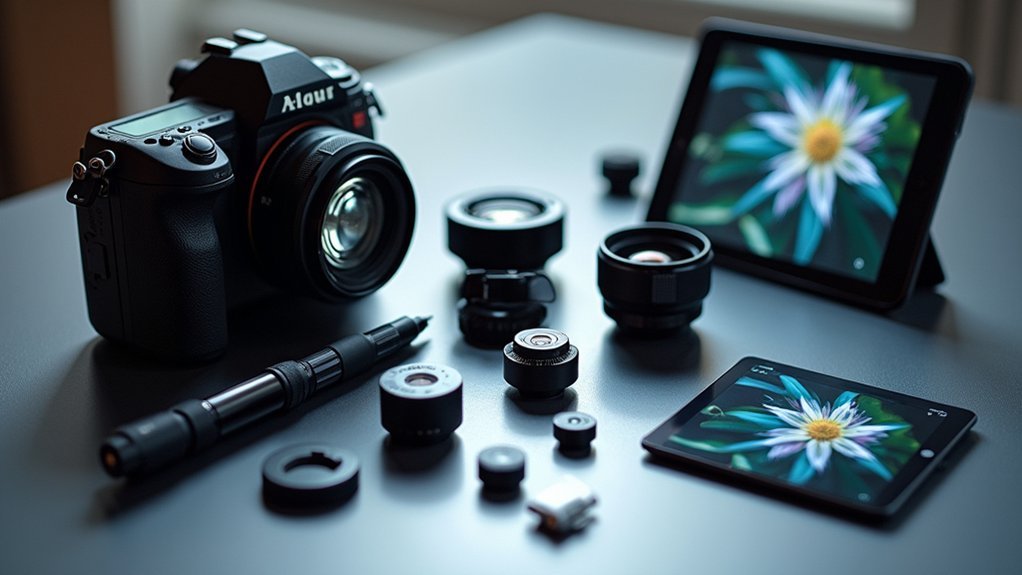
While focusing rails provide physical control over your focal plane, Z-Stack software extends your capabilities into the digital domain. This powerful tool merges multiple images taken at different focal points, creating a single photo with extended depth of field—particularly valuable for macro photography where achieving sharp focus throughout the frame is challenging.
You’ll notice dramatically improved image quality as Z-Stack selects only the sharpest areas from each input photo, effectively eliminating out-of-focus regions.
Most software options provide adjustable parameters for alignment and blending methods, allowing you to tailor results to your specific needs. With user-friendly interfaces and compatibility with various image formats, you can easily enhance your photography regardless of your experience level.
Customize your Z-Stack results through flexible alignment settings while enjoying intuitive controls across all common file formats.
Z-Stack software transforms what’s physically impossible with a single exposure into a crisp, fully-focused final image.
High-Resolution Digital Microscope Cameras
You’ll find that high-resolution digital microscope cameras distinguish between true optical resolution and simple magnification, ensuring you capture genuine detail rather than enlarged blur.
When setting up your microscope camera, proper calibration using standardized scales or test patterns will provide accurate measurements essential for scientific documentation and analysis.
The live view feature offers real-time focusing advantages, allowing you to make precise adjustments before capturing your final high-resolution images.
Magnification Versus Resolution
Understanding the essential distinction between magnification and resolution can dramatically improve your microscopic photography results.
While magnification (up to 1000x or more) brings tiny subjects closer, resolution (5-20+ megapixels) determines how sharp and detailed they appear. Without sufficient resolution, increasing magnification only produces blurrier images.
To achieve ideal microscopic photography:
- Balance your approach – Select camera resolution appropriate for your magnification needs; higher pixel counts capture finer detail at greater magnifications.
- Master proper lighting – Even the highest resolution cameras require excellent illumination to reveal intricate details.
- Perfect your focus techniques – Sharp images depend on precise focusing, which becomes more critical as magnification increases.
Remember that impressive magnification numbers mean little without corresponding resolution capabilities to maintain image quality and detail.
Calibration For Accuracy
Beyond achieving proper magnification and resolution, precise calibration of high-resolution digital microscope cameras forms the backbone of accurate microscopic photography.
You’ll find that even minor misalignments can drastically affect your focus and result in measurement errors.
For consistently sharp images, you should utilize certified calibration standards to verify your camera’s optical performance.
Modern cameras often include built-in calibration tools that simplify adjustments and track calibration status, enhancing both your photography experience and data reliability.
If you’re using your microscope camera frequently, recalibrate at least monthly to maintain precision.
This regular calibration not only improves image clarity but also guarantees accuracy across applications in materials science, biology, and manufacturing quality control.
The sharpness and precision of your microscopic photography directly depend on how well you maintain proper calibration.
Live View Focusing
Three critical advantages of live view focusing set high-resolution digital microscope cameras apart from traditional photography tools.
When working with subjects requiring extreme magnification, you’ll appreciate how these devices help overcome the minimal depth of field challenges.
- Focus peaking highlights in-focus areas, making it easier to identify critical focus points when capturing sharp images of tiny subjects.
- Adjustable lighting options including LED rings provide consistent illumination, eliminating shadows that could obscure important details.
- Real-time feedback allows you to make immediate adjustments to focus and composition, greatly improving workflow efficiency.
You’ll find that microscope cameras with live view focusing capabilities integrate seamlessly with analytical software, essential for scientific and medical applications where precision isn’t just preferred—it’s required.
Calibrated Stage Micrometers for Accurate Scale
Precision measurement sits at the heart of technical photography, with calibrated stage micrometers serving as vital tools for photographers who demand absolute accuracy.
These instruments feature scales marked in micrometers or millimeters, typically offering a standard 1mm length divided into precise increments.
To achieve sharp images, you’ll need to align the micrometer perfectly with your camera’s focal plane.
Perfect alignment between micrometer and focal plane isn’t optional—it’s the foundation of technical photography’s precision promise.
This alignment isn’t just about clarity—it provides essential data about your equipment’s true resolution and scale.
Regular calibration against known standards guarantees your photographic measurements remain reliable.
Piezoelectric Focus Controllers for Nanometer Precision
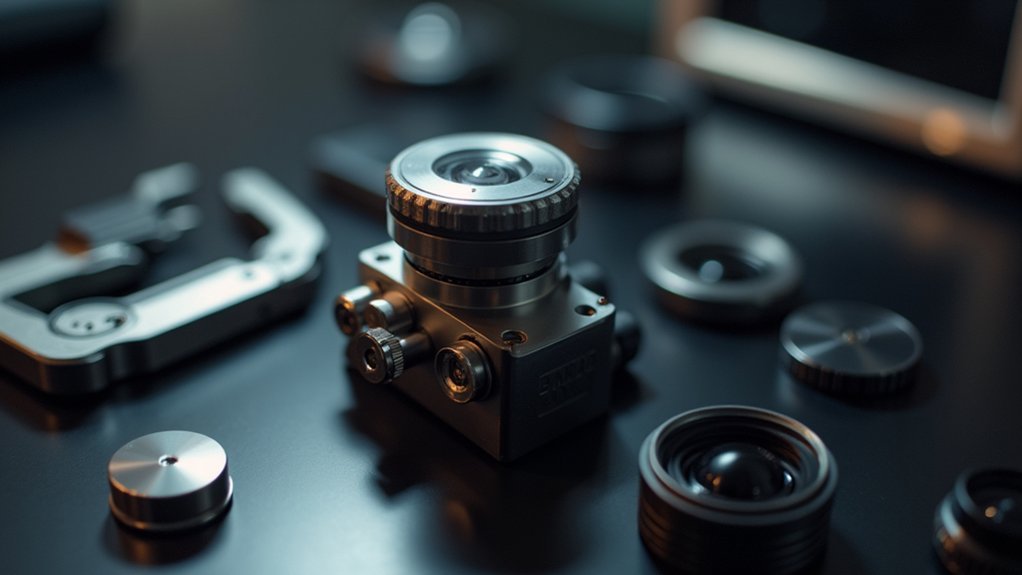
While calibrated micrometers help establish accurate measurement baselines, modern photography demands movement control at even finer scales.
Piezoelectric focus controllers offer you nanometer-level precision when adjusting your camera’s focal plane, ensuring you’ll focus right every time.
These sophisticated tools leverage materials that physically change shape when electricity is applied, delivering three key advantages:
- Ultra-precise adjustments – Control your focus at the nanometer level for incredibly sharp images
- Rapid response time – Experience virtually no lag between adjustment and result
- Environmental stability – Minimize focus errors caused by lens movement or vibration
Phase Contrast Objectives for Enhanced Detail Visibility
Although traditional camera lenses capture stunning images in most situations, phase contrast objectives reveal an entirely new dimension of detail visibility in your photography.
By leveraging differences in refractive indices, these specialized tools create contrast that highlights transparent structures you’d otherwise miss.
The unique optical design incorporates a phase plate that transforms light passing through your subject into interference patterns, enhancing detail without staining or altering your specimen.
This makes them invaluable for biological applications where you’re photographing living organisms in their natural state.
You’ll achieve higher resolution images with remarkable clarity, particularly when shooting microscopic subjects.
If you’re exploring microbiology or histology photography, phase contrast objectives let you document cellular components and tissue structures with nanometer precision while preserving their authentic appearance.
Differential Interference Contrast (DIC) Systems

Three key components—polarizers, compensators, and Wollaston prisms—form the foundation of Differential Interference Contrast systems, revolutionizing how you’ll capture transparent specimens.
These optical components work together to create stunning three-dimensional appearances in your images, offering texture and depth through polarized light interference.
For achieving sharper images in your microscopy work, make certain you:
- Properly calibrate and align all DIC elements to prevent quality degradation
- Utilize DIC for live-cell imaging to minimize photodamage to delicate specimens
- Pair with high-resolution microscopy techniques for ideal visualization of cellular structures
The DIC approach enables you to observe otherwise invisible details while preserving specimen integrity.
Uncover hidden cellular landscapes while keeping specimens intact—DIC microscopy transforms the invisible into remarkable visual data.
With proper setup, you’ll transform flat, transparent samples into visually striking, textured images with enhanced contrast and depth.
Focus Peaking Monitors for Real-Time Sharpness Feedback
Because precision focusing remains one of photography’s greatest challenges, focus peaking technology has transformed how you achieve tack-sharp images. This innovative feature overlays false colors on your viewfinder, instantly highlighting in-focus areas during manual focusing.
You’ll find focus peaking particularly valuable when working with modern lenses in macro, portrait, and product photography scenarios. Most current camera bodies—including Nikon Z, Sony A7, Canon EOS R, and Fujifilm X-T series—offer this functionality with customizable overlay colors to match your shooting environment.
While indispensable for precise manual focusing, be aware that focus peaking may underperform in low light or low-contrast scenes. For best results, combine it with other focusing techniques when working in challenging conditions to guarantee consistently sharp, professional-quality images.
Motorized XYZ Positioning Systems for Specimen Manipulation
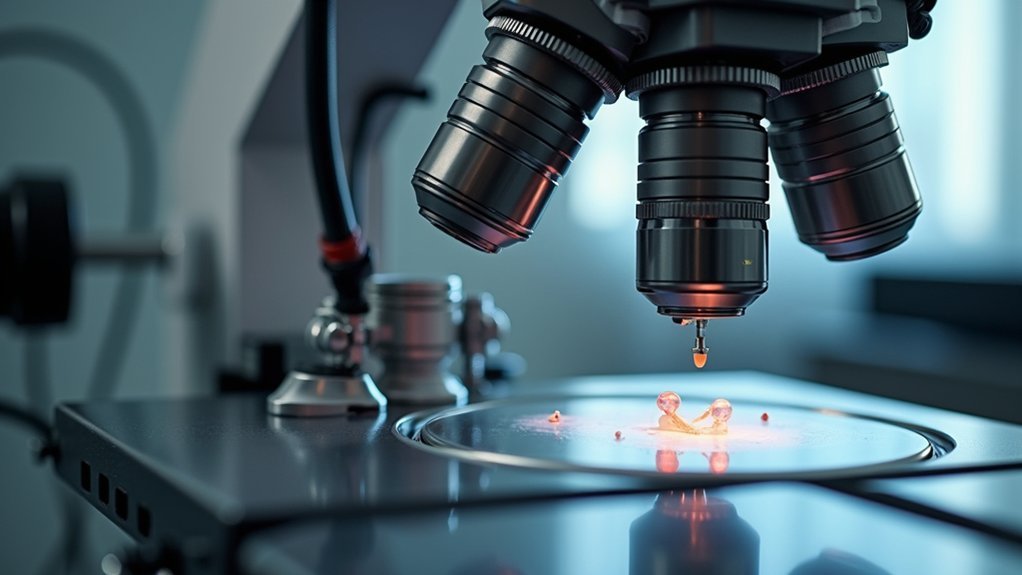
When precision beyond human hands becomes necessary, motorized XYZ positioning systems offer unprecedented control for specimen manipulation in photography.
These sophisticated tools eliminate the micro-vibrations that plague manual adjustments, guaranteeing peak image clarity and sharpness in your macro photography work.
With these systems, you’ll gain:
- Precise control along all three axes, allowing you to achieve perfect positioning for ideal depth of field
- Programmable movement sequences that guarantee consistent results across multiple imaging sessions
- Seamless integration with your existing microscopy or camera equipment, creating a versatile imaging platform
The high-resolution stepper motors provide the fine adjustments needed for critical focus work, particularly valuable when photographing specimens where even minimal positioning errors can compromise your final image quality.
Frequently Asked Questions
What Is the 20-60-20 Rule in Photography?
The 20-60-20 rule suggests you’ll create balanced compositions by allocating 20% of your image to foreground, 60% to middle ground, and 20% to background, guiding your viewer’s eye through the photograph effectively.
How to Get Super Sharp Photos Every Time With Any Camera?
You’ll get consistently sharp photos by using a tripod, setting aperture to f/8-f/11, following the focal length shutter speed rule, utilizing focus peaking, and always double-checking your focus before shooting.
How to Get Sharp Focus in Photography?
To get sharp focus in photography, you’ll need to use the right aperture (f/8-f/11), follow the shutter speed focal length rule, utilize focus peaking, steady your camera with a tripod, and double-check your focus often.
What Shutter Speed Is Needed for Sharp Photos?
You’ll need a shutter speed of at least 1/focal length for sharp photos. For example, use 1/50s with a 50mm lens or 1/200s with a 200mm lens when shooting handheld.
In Summary
You’ve now discovered the essential tools for achieving precision focus and incredible sharpness in your photography. By incorporating these specialized focal plane instruments into your workflow, you’ll capture details you never thought possible. Remember, it’s not just about having the right camera—it’s about mastering the focal plane. Start with one or two of these tools, and you’ll immediately notice the difference in your image quality.

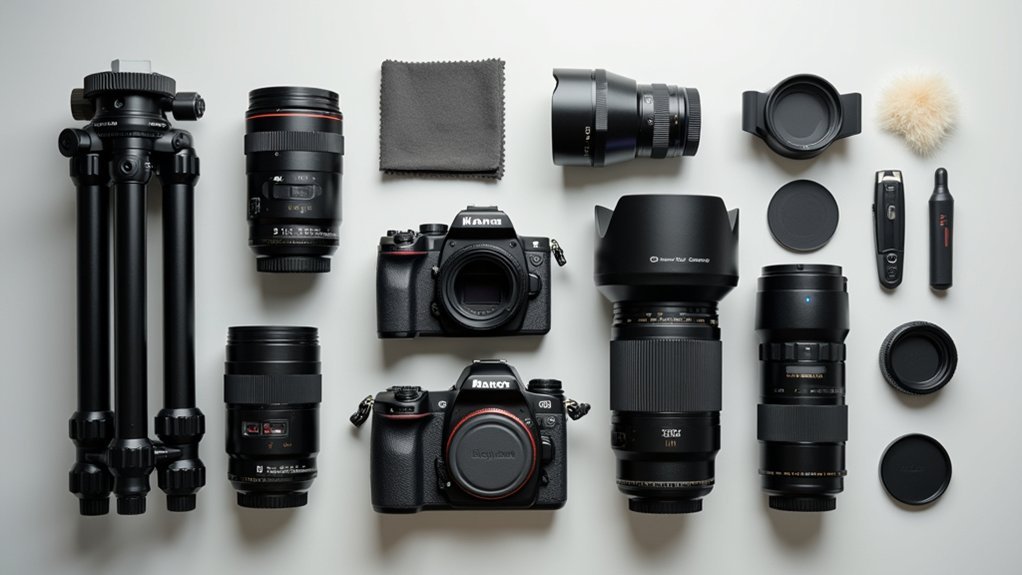



Leave a Reply